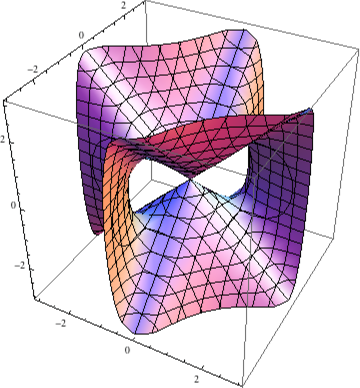| << Chapter < Page | Chapter >> Page > |
so that for with very small,
and dividing through by , we get
Now, since and as and stays bounded, for and we find that
This implies that
so that the slope of the tangent line is a root of the polynomial . Equivalently, is a factor of and is a factor of as desired (Why?).
If we had been dealing with a vertical tangent, then we could have divided through by instead, and we would find that
which implies that 0 must be a root of the polynomial so that is a factor of the polynomial .
It turns out that, at least over the complex numbers, the converse of this proposition is true as well: if is a factor of , then near the origin there is a branch of the curve having as its tangent line at the origin.
We call that smallest degree of a non-zero term of the multiplicity of the curve at the origin. Since is often the union of the tangent lines to branches of the curve at the origin (and at least always contains those lines) we'll give it a name: we call the tangent cone of at the origin and denote it .
We said that we could move a singular point of to the origin by a change of coordinates, but we could also have done everything with Taylor expansions centered at any point : we set to be the degree part of regarded as a polynomial in and , as can be computed by Taylor expansion
We can then define the multiplicity as before as the the smallest number so that , and define the tangent cone to at to be . One can check that this agrees with what we'd get by instead translating the curve so that goes to the origin, computing the tangent cone at the origin as above and then translating back.
One might wonder where the term “cone” is coming from here given that there is no cone in the traditional sense in sight. The answer is that the term “cone” is often used more generally to refer to any locus traced out by lines through some fixed point (the vertex of the “cone”). Here, the “base” of the tangent cone of our plane curve might be regarded as finitely many points, one for each tangent direction. While this can never really look much like a more familiar cone in the case of plane curves, it is possible for a “tangent cone” to a singular point on a surface to actually be a “cone” in the original sense (see [link] ).


Exercise Show that if is a homogeneous polynomial (all of its terms have the same degree), then its zero locus is a cone with vertex , i.e. if then for all .

Notification Switch
Would you like to follow the 'The art of the pfug' conversation and receive update notifications?